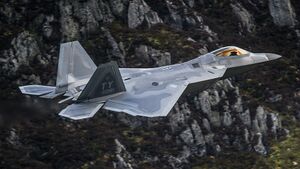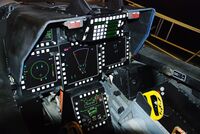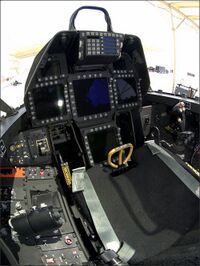JAS-62 Vampyr
| JAS-62 Vampyr | |
|---|---|

| |
| An RAAF JAS-62C | |
| Role | Air superiority fighter |
| National origin | |
| Manufacturer | MDA SE |
| Design group | MDA SE Aestrup ASA |
| First flight | 20 July 1996 |
| Introduction | 20 December 2005 |
| Status | In active service |
| Primary user | |
| Produced | 2005—Present |
The MDA JAS-62 Vampyr is an Acrean single-seat, twin-engined 5th generation air superiority fighter designed by MDA SE and Aestrup ASA for the Royal Acrean Air Force. The aircraft was developed as an air superiority fighter, but has been equipped with electronic warfare and signals intelligence capabilities as well as limited ground strike capability since its introduction.
Development
Design
Overview
The JAS-62 is a twin-engined, air superiority stealth fighter.
Initially equipped with the EJ-915 turbofan, later models of the Vampyr are produced with two EJ-920 turbofans, increasing thrust to 41,000-lbf thrust rated 920s. These engines were found to produce high temperatures within the engine intakes- a problem consistent across EJ-900 series engines resulting from the necessary operating conditions to produce their high thrust. As a result, extensive work is undertaken on aircraft equipped with 900-series engines to develop to hide their thermal signature. Drakens, Vampyrs, and Strigas in particular are known for their distinctive "howls" caused by intake shaping and radar-defeating mechanisms. Radar stealth is primarily achieved through the use of radar-absorbent materials baked into the airframe's skin and airframe shaping. Both the Vampyr and the Striga utilise composite airframe skins and construction to aid in stealth and durability. An electronic warning and countermeasure system is integral to both airframes enables them to target and jam hostile radars and radar-guided missiles.
Its sensors and computer systems constitute the most complex and expensive parts of the aircraft's development. The Vampyr carries an AESA radar, complimented by an IRST equipped with a magnified long-range optical sight to aid in long range identification, an electronic countermeasure system, and SAIRST/DAS consisting of high-resolution infrared sensors distributed around the airframe to provide full spherical coverage. The SAIRST and the aircraft's RWR provide detection of both infrared and radar-guided missile launches, and the SAIRST also directs infrared imaging countermeasure against incoming infrared missiles. The Vampyr utilises data link to share information gathered through its variety of sensors with both friendly Air Force and Navy aircraft.
The Vampyr possesses three weapon bays, with one main under-fuselage bay and two side-fuselage bays. The standard air-to-air loadout for a Vampyr is six M-13 MSRA active radar homing missiles and four M-9 IRSS infrared missiles, both of which were developed to be more compact in order to increase capacity within the internal weapons' bays of next generation fighters.
Avionics
The Vampyr served as the impetus for the development of MEGINGJÖRD, an integrated avionics and sensor suite in which information gathered through its multitude of sensors and systems are filtered, synthesised, and displayed on the pilot's displays to enhance situational awareness and reduce the workload of the pilot. A development of the JAS-62A's avionics, MEGINGJÖRD-E was introduced on the Vampyr in 2016. Key sensors on the aircraft are its Kobalt-Zeiss AR/ASM-06 active electronically scanned array (AESA) radar, MDA EK/RMG-11 electronic warfare and countermeasure system, and a Kobalt-Zeiss OS/IRN-D suite which includes the aircraft's infrared search and track sensor slaved to a magnified optical sight, a separate electro-optical targeting system, and its infrared distributed aperture system, and its CNI suite. The avionics of the Vampyr are designed to communicate with one another to complement roles; the AESA radar provides a component of the electronic warfare system, for instance. They filter, and synthesise the information gathered and present it as a cohesive, comprehensive image of the battlespace to the pilot. The AR/ASM-06 radar is reported to provide a tracking range in excess of 150km, and is complemented by the OS/IRN-D, a component of the Vampyr's SOL Combat Avionics Suite. The OS/IRN-D's IRST allows the aircraft to detect airborne targets at a reported range of up to 100km, and surface or sea targets at 10km. Full target tracking and identification is reportedly slightly closer than the maximum detection range of the IRST, while tracking range with necessary quality and precision for weapons guidance is further limited. A primary function of the IRST is use against opposing 5th generation aircraft to allow it to detect, vector onto, and engage said aircraft. It can also use this capability to vector onto and track enemy aircraft without eliciting radar emissions that would reveal its presence. The OS/IRN-D's distributed aperture system consists of several infrared optical sensors arranged around the aircraft that works in conjunction with the RWR of the EK/RMG-11 to provide all-aspect missile launch warnings for both radar-guided and infrared-guided munitions, as well as increased situational awareness. Although the sensors can detect and provide a basic track to the pilot, they are unable to provide adequate tracking for weapons. The pilot's head-mounted display tracking was considered sufficient to provide tracking for the aircraft's high-off boresight M-9 IRSS missiles. In addition to OS/IRN-D, SOL provides conformal electronic countermeasure pods distributed along the wing roots of the aircraft. Networking with the missile warning system provided by the SAIRST, the SOL pods use directed infrared light to attempt to confuse or spoof the seeker of incoming infrared missiles, enhancing survivability especially when combined with other defensive measures like flares and evasive maneuvering. The Vampyr can rapidly provide information and targeting data to friendly aircraft via datalink, although it does not possess a radar as powerful as dedicated platforms. The deliberate upgradeability designed into the airframe both via software and ease of hardware replacement allows these systems to be easily and efficiently swapped and updated.
Stealth and Infrared Signature
Radar cross section (RCS) has been minimised through a combination of deliberate airframe shaping, use of composite materials in the airframe, and radar-absorbent materials on the skin of the aircraft. An important development shift from earlier prototypes of the JX fighters is the use of composite fibermat skin on production JAS-62 and EF-650 fighters, which provides increased low-observability through its radar-absorbent qualities and is more durable, reducing maintenance. The durability of the aircraft is particularly notable, and both the airframe and its baked radar-absorbent coatings are durable in open weather. It uses diverterless supersonic intakes which hide the fan blades of the engine, a common source of radar returns. All of its stealth characteristics are aimed primarily at high-frequency X-Band radars such as those found on fighter aircraft or ground-based SAM sites ; although they are detectable on low-frequency radars such as those used for early warning or weather, these radars are unable to provide precise or accurate tracking and are unable to guide weapons. These types of radars are also very conspicuous and vulnerable. Likewise, it is reported that it can also be detected by military very high frequency (VHF) radars, although only at short range and with low accuracy. The Vampyr also utilises a combination of shaped exhaust nozzles, composite materials, and infrared-absorbent materials to reduce its infrared signature.
Cockpit
The Vampyr utilises a full glass cockpit and all-digital flight instruments. The head's up display (HUD) was traditionally used as the primary flight instrument prior to the introduction of improved high-fidelity HMDS in 2014, and information was displayed originally on six liquid-crystal multi-function displays arranged in the cockpit. This cockpit design was changed slightly over the lifespan of the JAS-62A. The six LCD MFD displays were replaced by six LCD touchscreen MFDs with greater fidelity and resolution; despite the addition of touchscreen capability, the buttons for manipulating the MFDs were retained by demand of pilots. The cockpit displays underwent additional updates in 2015. The few aircraft produced prior to the change in late 2008 were quickly retrofitted with the new cockpit, and all aircraft received an updated ejection seat.
Engines
The Vampyr was originally equipped with two EJ-910 afterburning turbofans. Developed from the EJ-900+ which outfitted flying prototypes of the Vampyr as well as was fitted to the EF-135, the EJ-910 was the most powerful fighter engine in Acrean service upon its introduction producing 116 kN (26,077 lbf) of dry thrust and 156 kN (35,000 lbf) of thrust in reheat. The EJ-920 was later developed from the EJ-910 to equip the single-engined EF-650. Although the EJ-920 is notable more powerful than even the EJ-910, the thrust and capability provided by the EJ-910 was considered more than sufficient for existing aircraft, and the cost of replacing the engines on the entire fleet not worth the relative increase in performance. The EJ-900 series engines have a reputation for their responsiveness to throttle inputs, high thrust, and exceptional acceleration to support the traditional energy- and rate-oriented characteristics of Acrean fighters.
The engines aid in the Vampyr's stealth through the use of low-observable afterburners which uses fuel injectors incorporated into curved vanes in the engine covered by radar-absorbent ceramics and mask the engine turbine. The EJ-910 and EJ-920 possess the same notably high intake temperatures common to all EJ-900 series engines, which were addressed through additional work to provide infrared shielding to the engine intakes and bodies. The engines produce a distinctive "howl" and are known to be louder in comparison to other jets. Subsequent testing done for residential areas near airbases in Acrea showed that the Vampyr's engines are fairly equal in decibel level to other jets, but produce much stronger low-frequency noise resulting in greater perceived volume. The EJ-910 and EJ-920 incorporate improved MAVS thrust vectoring systems first introduced on the EJ-900-94 engine, providing thrust vectoring in all axes.
Operational History
Zemplen War
The Vampyr saw extensive use with VF-83 during the Zemplen War, and was tasked with reinforcing and in many places replacing Ruvelkan fighters in conducting offensive and defensive counter air operations. The aircraft's situational awareness, sensors, and low observability were considered not just immense tactical advantages, but also provided much-needed strategic benefits by reducing the number of fighter aircraft necessary in a given area as a single Vampyr could perform the job of a few Dragos. Thus, it freed up Ruvelkan airpower to be redeployed elsewhere as necessary with no practical loss in security or capability. Over the course of the war, VF-83 achieved 41 air-to-air victories and suffered no losses and produced two aces- Thor Neuer and Noemi Schweighöfer.
The performance of the Vampyr during its debut in the Zemplen War was understood by the Acreans as a vindication of expectations. Although testing with pre-production Vampyrs in simulated engagements with A-series Drakens in 2003 and 2004 had demonstrated the jump in tactical capability, it wasn't until the Vampyr entered combat in the skies over Ruvelka and Syara that both the RAAF and Parliament were fully convinced of its value over existing 4.5 generation fighters.
Midsummer War
Large numbers of Vampyrs were deployed for the first time as a critical component of the Coalition's air campaign against Æþurheim during the Midsummer War. Serving primarily in the offensive counter-air role, RAAF Vampyrs achieved the highest air-to-air kill ratio of any aircraft type in the war, scoring 62 aerial victories while suffering no losses.
Variants
- JAS-62A Block I - Original production aircraft introduced into service in 2005. Saw combat service in the Zemplen War.
- JAS-62A Block II - Introduced an updated cockpit layout and fire control system. All in-service Block 6s were updated to Block 8 standard by the end of 2009, designated the Block 5-8.
- JAS-62C Block 16 - The JAS-62C is the second production variant of the Vampyr and introduces a variety of major changes and improvements not just to the aircraft's performance, but to its economic feasibility and sustainment. The C-series aircraft features updated composites and construction. It uses a composite skin with integrated fibermat radar-absorbent material and superior corrosion resistance to the JAS-62A, significantly improving durability and reducing costs during production. The flight control system's hydraulics were replaced with electro-hydraulic actuators. The JAS-62C also introduced the MEGINGJÖRD avionics suite, with the Vampyr using the MEGINGJÖRD-E model of the suite. This allows the Vampyr the ability to operate near-seamlessly with other types of Acrean aircraft, in particular those equipped with their own variants of the MEGINGJÖRD suite. The adoption of the new avionics also meant the introduction of a new cockpit, which uses a wide-area display similar to the EF-650 Striga and other fighters updated with the new avionics. The RAAF has slated 50 new aircraft for production by 2030, with existing aircraft to undergo major overhauls.
- JAS-62C Block 19 - C-series aircraft with more powerful EJ-920-7 engines and infrared shielding around engines and exhaust improved.
Operators
Current Operators
Specifications (JAS-62C Block 19)
General Characteristics
- Crew: 1
- Length: 19.92 m (62 ft 1 in)
- Wingspan: 13.56 m (44 ft 6 in)
- Height: 5.08 m (16 ft 8 in)
- Wing Area: 78.04 sq. m (840 sq ft)
- Empty Weight: 19,800 kg (43,652 lbs)
- Powerplant: 2 x EJ-910 afterburning turbofan, 116 kN (26,000 lbf) dry thrust, 156 kN (35,000 lbf) reheat
- Fuel Capacity: 8,200 kg (18,000 lb) internal fuel
Performance
- Maximum Speed: Mach 2.3 at altitude
- Mach 1.8 supercruise at altitude
- Service Ceiling: 20,000 m (65,000 ft)
- G-Limits: +9.0/-3.0
Armament
- Guns: 1 × 20 mm cannon with 510 rounds
- Payload: 10 internal hardpoints, ability to attach 6 additional external hardpoints.


